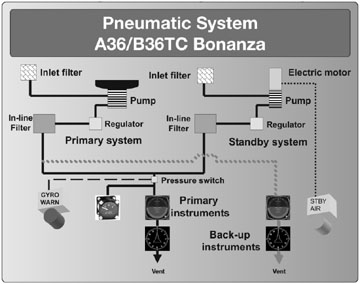By Thomas P. Turner
It shouldnt come as a surprise to learn that piston-powered airplanes have a number of limitations on their suitability for all-weather operations. Pilots-and Aviation Safety readers-have been known to argue vociferously about the relative safety and utility of various powerplant and system configurations. While consensus rarely results, few disagree on the need for some way to backup light-aircraft gyro instruments.
Especially in the case of IFR operation of older aircraft with gyros powered by air or vacuum pumps, we consider it essential that some sort of back up plan or equipment is carried. And even if you fly a newer aircraft with an all-electric system considered more reliable than a pneumatic one, you still may encounter failure modes leaving you without reliable gyro instruments. How important is a reliable backup to your primary gyro instruments? What are some of the pitfalls? What can you do to make the panel in your piston single or twin as reliable as possible?
Two Examples
To set the stage, lets consider two examples of what can happen aboard a well-equipped aircraft flown by reasonably competent pilots when the primary gyro instruments fail.

On November 26, 1999, at about 1053 local time, a Beechcraft S35 Bonanza was destroyed when it impacted a building in a residential area of Newark, N.J. The Airline Transport pilot and his two passengers received fatal injuries. In addition, two individuals on the ground were seriously injured and 25 received minor injuries.
Daytime instrument conditions prevailed, and an IFR flight plan was filed. Shortly after departing the Linden, N.J., airport, the pilot reported to ATC, I think I have a problem, and requested a climb. Radar data showed the airplane heading east at an altitude of approximately 900 feet when the pilot first reported the problem. Over the next two minutes, the targets ground track changed from east, to north, to northeast, to northwest and then back to north. In the last 30 seconds of radar data, the target reached a maximum altitude of 2800 feet and 161 knots of airspeed before beginning a descent that reached approximately 10,000 fpm.
Although there were medical anomalies that may or may not have played a part, post-crash investigation revealed that the Bonanzas heading indicator and turn coordinator appeared to be inoperative at the time of impact.Ironically, the pilot-in-command, Dr. Itzhak Jacoby, was considered a leading expert on partial-panel flight.
Then, on October 16, 2000, in night IMC over Missouri, the pilot of a Cessna 335 piston twin reported were having some…problems with (the) primary attitude indicator. The pilot later reported he was having to try and fly (using the) copilot or right-side attitude indicator-a task the NTSB later noted would have resulted in the pilot making frequent, rapid head movements to crosscheck that instrument with other instruments…most likely (causing the pilot) to experience spatial disorientation. Shortly thereafter, control of the Cessna was lost and all aboard, including Missouri Governor Mel Carnahan, died in the crash.
Industry Outcomes
The Jacoby and Carnahan tragedies resulted in several changes throughout the general aviation industry. For example, they generated the inevitable lawsuits, justified or not, and forced some vacuum pump manufacturers out of the market. A greater number of pilots who fly hard IFR are equipping their airplanes with redundant gyro power systems. Theres a growing market for backup flight instrumentation.
Most notably, theres a groundswell of distrust for air-driven flight instrumentation. Whether its concern about failure of what is truly an antiquated means of powering gyroscopes, or consideration of the weight and complexity of a vacuum or pressure system that powers in many cases but a single instrument, the all-electric panel is coming into its own.
The death knell for the vacuum system is the introduction of all-electric, glass panel flight management systems. Combined with weeping wing or electrothermal deicing systems in known ice airplanes, glass cockpits will likely make instrument air systems about as common as venturi tube-driven gyros in future production airplanes. Glass cockpit airplanes are required to have a steam-gauge attitude indicator (AI) as backup (along with a pitot-static altimeter and airspeed indicator), but all the glass-cockpit airframe manufacturers are going with electric backup AIs. Physical placement of the backup AI in some models of glass airplanes is the biggest limitation on their safe usefulness in partial-panel flight (See Broken Glass, June 2005).
Diagnosing Dead Gyros
The hardest part of flying partial panel is discovering that an instrument has failed in the first place. The old CFI standby of covering an instrument with a soap dish and announcing you have an instrument failure doesnt prepare students for diagnosing the death of a gyro or the system that powers it. As evidence, the sidebar on the opposite page details a recent study highlighting those difficulties.
Instrument cross-check is vital to identifying a failed instrument-comparing each instruments indications to the others to find a discrepancy, and then using majority rule of instruments in agreement to identify the one thats died. If youve replaced your turn coordinator or turn-and-bank with a redundant AI, youll still need to check it against the other instruments to see if the primary or the backup AI has died. If your airplane has gyro-related warning annunciators, also use these to make your diagnosis.Heres a technique for troubleshooting the flight instruments and identifying a failure:
1. As always, fly the airplane.
2. Loosen your grip on the control yoke to avoid overcontrolling.
3. Look for instrument failure warning flags and/or annunciators.
4. Check the suction or instrument air gauge.
5. Check appropriate system gauges and circuit breakers to identify a possible electrical gyro problem.
If youre still unable to determine which instrument(s) has/have failed:
1. Hold what appears to be a level attitude and note instrument indications.
2. Apply a small amount (+/- two degrees) of increased pitch and verify proper altimeter and VSI indications.
3. Return to level pitch, then make a shallow (+/- five degrees) right bank (in U.S.-manufactured airplanes, a right bank resists spiral entry while a left bank adds to the tendency because of propeller torque) and verify proper AI, heading and (if equipped) turn coordinator/turn-and-bank indications.
This exercise can help you safely and methodically compare instrument indications and determine which (if any) has/have failed.
Once youve confirmed instrument and/or system failure, engage any backup instrument power source (standby air pump or standby alternator/generator).If unable to return the failed instrument to service, cover it up to avoid distraction (I use Post-It notes, which I keep in my shirt pocket on all flights in case of an actual failure) and configure your airplane for partial panel flight.
Going Mobile
If the 1980s was the genesis of hand-held radios and the 1990s was the era when Loran, GPS and moving maps gave IFR pilots a truly independent means of navigation and situational awareness, then the first decade of the 21st century may be the time when GPS-based flight displays supply an independent backup to installed flight instrumentation. Garmin Internationals GPSMAP 196, 296 and 396 hand-held navigators feature a panel display replicating the sacred six instruments using GPS-derived data. Ive not yet had the opportunity to try the exercise myself, but a number of pilots I know report having successfully flown hand-held partial panel under a sheet or similar view limiting device, with a safety pilot looking outside, of course. The only potential gotcha of a GPS-derived instrument display is that, despite looking like an airspeed indicator, the GPS-indicated velocity is ground, and not air, speed.
Other options include some combination of the portable computers seeing increasing popularity in todays cockpits. For not much coin, one can carry a self-contained, battery-powered gyro system using a PDA to display the airplanes attitude. Properly configured, these products-like the PPCEFIS hardware/software solution from PCFlight Systems highlighted in the sidebar on the opposite page-also display GPS-derived groundspeed and other data.They may also be used to provide a moving map with terrain data, for example, or to manage and display near-real-time weather information.
However, Garmin introduced the $2495 (street price) GPSMAP 396 last summer. Since then, this color-screen portable GPS navigator with a virtual instrument panel, XM WX Satellite Weather capability and host of other features has easily moved into the top slot among must-have portable cockpit devices-and among portable gyro back-up systems.
Wake-Up Call
Only about two-thirds of the IFR-current pilots participating in the FAA/AOPA study discussed in the sidebar on page 12 could successfully complete a partial-panel instrument approach. A quarter of the pilots flying a high-performance airplane could not avoid slipping into a deadly spiral before even recognizing an instrument failure. And given that the subject pilots were all volunteers for an IFR evaluation, notes the FAA/AOPA report, it is likely (the) volunteers were more proficient than average general-aviation pilots.
In its conclusion, the FAA/AOPA report makes two recommendations:Training: Attention should be given to practicing detection and diagnosis of instrument failures in as realistic a setting as possible. This should include simulators, aviation training devices, and/or aircraft with vacuum systems specially adapted for the removal of power from at least one attitude instrument on the trainees side of the panel.
Warning indicators: Failure indicators should be located as close to the primary panel as possible and should be very conspicuous. Attitude indicators should be flagged to indicate loss of power. This can be done by referencing gyro rpm and displaying an alert below the minimum necessary for reliability.
The report also suggests installing a heading indicator using a power source independent of the attitude indicator, combining instruments as much as possible to reduce workload. An example would include an HSI combining heading and navigation information, and installing a backup AI.
The FAA/AOPA study and the tragic accident history prompting it tells us that the way we traditionally teach partial-panel recognition and reaction may not be up to the task of developing the skills needed to survive actual instrument failure in IMC. And the tools we use as back-up may need some improvement, also.
Also With This Article
“A Telling Study”
“Dont Make A Bad Situation Worse”
“Transitioning To Partial Panel”
“Wet Versus Dry”
-Tom Turner is a CFII-MEI who frequently writes and lectures on aviation safety.




